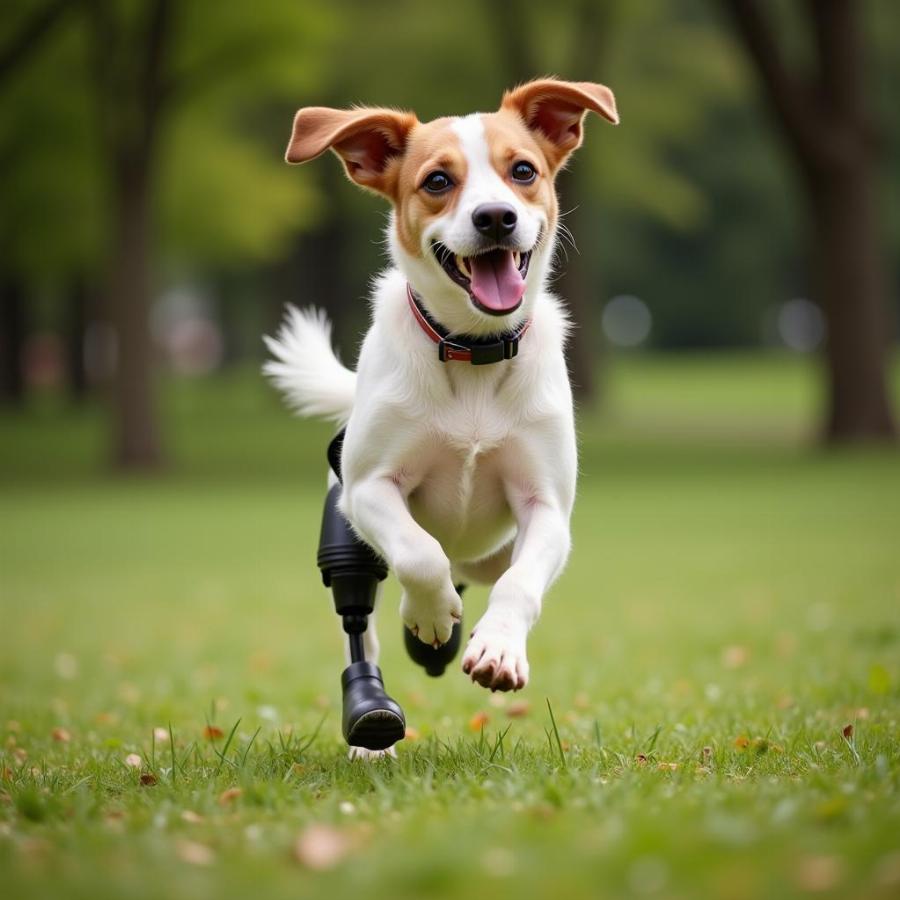A dog prosthetic leg, also known as an artificial limb, can dramatically improve the quality of life for dogs who have lost a limb due to injury, illness, or congenital defect. These innovative devices offer a chance for amputee dogs to regain mobility, independence, and joy. Choosing the right prosthetic for your furry friend involves careful consideration of factors like the dog’s size, weight, activity level, and the location of the amputation. This guide will delve into everything you need to know about dog prosthetic legs, from understanding the different types available to the fitting process and aftercare.
Understanding the Need for a Dog Prosthetic Leg
Why might a dog need a prosthetic leg? Several reasons could lead to this necessity, including traumatic accidents, cancerous tumors requiring amputation, and congenital deformities. A missing limb can significantly impact a dog’s balance, mobility, and overall well-being. It can lead to joint strain in the remaining limbs, back problems, and even psychological distress. A prosthetic leg can alleviate these issues, restoring a dog’s ability to walk, run, and play, ultimately improving their quality of life.
Types of Dog Prosthetic Legs
Just like human prosthetics, dog prosthetic legs come in various designs and materials. Some common types include:
- Partial Limb Prostheses: These are used when a portion of the limb remains and are designed to support and protect the remaining limb while providing some mobility.
- Full Limb Prostheses: These replace an entire limb and are attached to the dog’s residual limb with a custom-made socket.
- Carts: These are wheeled devices that support the dog’s hindquarters, offering stability and mobility for dogs with paralysis or missing hind limbs.
The Fitting Process for a Dog Prosthetic Leg
The process of getting a dog prosthetic leg is a collaborative effort involving you, your veterinarian, and a certified prosthetist. It begins with a thorough evaluation of your dog’s condition and amputation site. The prosthetist will then take measurements and create a custom-made socket that fits snugly and comfortably. prosthetic devices for dogs The prosthetic leg is then attached to the socket, and your dog will undergo a period of adjustment and rehabilitation to learn how to use the new limb.
Aftercare and Maintenance of a Dog Prosthetic Leg
Proper aftercare is crucial for the success of a dog prosthetic leg. Regular cleaning of the socket is essential to prevent infection. dog leg amputation You should also inspect the prosthetic regularly for any signs of wear and tear and schedule follow-up appointments with the prosthetist for adjustments and maintenance.
Cost of a Dog Prosthetic Leg
The cost of a dog prosthetic leg can vary depending on the type of prosthetic, the size of the dog, and the complexity of the case. It’s essential to discuss the costs with your veterinarian and prosthetist to get a clear understanding of the financial commitment involved.
Is a Prosthetic Leg Right for My Dog?
Deciding whether a prosthetic leg is right for your dog is a significant decision.  Chó dùng chân giả It’s crucial to consider your dog’s overall health, age, and temperament. artificial limbs for dogs Consult with your veterinarian to determine if your dog is a good candidate for a prosthetic and to discuss the potential benefits and risks.
Chó dùng chân giả It’s crucial to consider your dog’s overall health, age, and temperament. artificial limbs for dogs Consult with your veterinarian to determine if your dog is a good candidate for a prosthetic and to discuss the potential benefits and risks.
Conclusion
A dog prosthetic leg can be a life-changing intervention for dogs who have lost a limb. These devices can restore mobility, improve quality of life, and bring back the joy of running and playing. By understanding the types of prosthetics available, the fitting process, and aftercare requirements, you can make an informed decision about whether a dog prosthetic leg is the right choice for your beloved companion.
FAQ
- How long does it take for a dog to adjust to a prosthetic leg? This varies from dog to dog, but it typically takes several weeks to months.
- Can all dogs use a prosthetic leg? Not all dogs are suitable candidates, and a veterinarian’s assessment is crucial.
- What is the lifespan of a dog prosthetic leg? This depends on usage and wear and tear, but they typically need replacing periodically.
- Are there any alternatives to prosthetic legs for dogs? Yes, options like carts and harnesses can provide support and mobility.
- How do I clean my dog’s prosthetic leg? Your prosthetist will provide specific cleaning instructions.
- What kind of activities can a dog do with a prosthetic leg? Many dogs can return to normal activities like walking, running, and playing.
- How do I find a qualified prosthetist for my dog? Your veterinarian can refer you to a reputable prosthetist specializing in animal prosthetics.
Expert Insight:
Dr. Emily Carter, DVM, Certified Canine Rehabilitation Therapist: “Prosthetic legs can be incredibly beneficial for dogs, allowing them to regain mobility and live fuller lives. It’s essential to work with a qualified team to ensure the best outcome for your furry friend.”
Dr. John Miller, Certified Prosthetist: “A well-fitted prosthetic can transform a dog’s life. The key is a collaborative approach between the owner, veterinarian, and prosthetist to create a device that meets the dog’s individual needs.”
Sarah Jones, Certified Veterinary Technician: “Seeing a dog regain their mobility with a prosthetic leg is truly rewarding. It’s important for owners to understand the commitment involved in aftercare and rehabilitation to ensure the prosthetic’s success.”
Beaut Dogs is the ultimate destination for dog lovers, providing trustworthy, in-depth information on all aspects of dog ownership. From breed information to expert advice on care and training, we’re here to help you navigate the world of canine companionship. When you need expert advice, please contact Email: [email protected] to get detailed and accurate answers from Beaut Dogs. Visit Beaut Dogs today!